Abstract
Human impacts cause significant problems for shallow lakes in the karst regions of South China. In recent years, the ecological issues related to managing and restoring these critical aquatic ecosystems have come to the fore. Lingshui Pool (LSP) is one of the most-studied spring-fed lake ecosystems in south China, and it has well-preserved chronological profiles. The LSP was a very shallow lake before dam construction in 1962. Due to the dam’s construction, rapid development and urbanization, this important freshwater ecosystem has suffered severe eutrophication and environmental degradation. In order to determine the environmental effects of recent anthropogenic disturbances and establish conservation recommendations for this lake ecosystem, we analyzed diatoms and weak-acid leachable elements from a well-dated sediment core from LSP to reconstruct the changes in aquatic conditions and diatom diversity during the period AD 1960–2013. This revealed shifts in diatom assemblages, diversity, and geochemistry that were strongly linked to the construction of a dam in 1962 and rapid eutrophication after 1990. Diatom diversity was stable and relatively high when submerged macrophytes were present between 1962 and 1990. Thus, the reintroduction of endemic macrophytes could benefit the ecological stability and diversity of this shallow lake.
1. Introduction
Spring-fed lakes in karst areas are highly vulnerable freshwater ecosystems that are affected by the input of substantial amounts of materials from regional groundwater systems and local watersheds [1]. Groundwater quality is affected by land-use and landcover change, climate warming, and human activities on a regional scale [2], and it is strongly correlated with the ecosystem dynamics of lakes. The effects of human activity in the local environment, such as land development, eutrophication and pollution, are also a challenge for sustainable aquatic ecosystem management, especially in densely populated areas.
Dam construction is crucial to capture water and to create a reservoir upstream. However, dams may alter the freshwater ecosystem, including reducing irrigated areas, changing the river’s organisms and modifying sedimentary loading [3]. Since 1950s, the Chinese government has constructed approximately 95,000 small reservoirs (capacity < 107 m3) to support local agriculture [4]. With increasing concerns regarding water quality, assessing the effect of dam construction on the freshwater ecosystem in a small reservoir will improve our understanding of sustainable management. Lingshui Pool (LSP) is a typical karst spring-fed perennial lake system in South China. Previous studies of LSP have focused on understanding the decreased resilience of the lake ecosystem in relation to water-quality deterioration using decadal monitoring data or historical data on water chemistry, physicochemical parameters, and phytoplankton [1,5]. A more recent report has addressed the issue of anthropogenic effects on LSP. This study found that reductions in upstream discharge, increases in water consumption, and strengthening of river backflow events had caused degradation of the aquatic ecosystem that comprises LSP [6]. However, no long-term (more than 10 years) and continuous record of the aquatic condition of the system has yet been published.
From an ecological perspective, long-term records are needed to quantify the effects of environmental variation on lake ecosystems and refine lake management efforts [7,8]. Undisturbed lake sediments are natural archives that can be used to reconstruct long-term and recent natural dynamics of the aquatic ecosystem under the impact of anthropogenic disturbances and climate changes [9,10,11].
To reconstruct past ecosystems and biotic responses, multi-proxy methods can gain a wider and more reliable overview than a single-proxy method [12]. Diatoms are indicators of an aquatic ecosystem’s health, and are widely used to assess natural and anthropogenic features of aquatic environments [7,13,14]. Acid-leachable geochemical proxies in lacustrine sediments are sensitive to water chemistry and correspond well to climatic and hydrological conditions, such as water level, eutrophication and water chemistry [15,16]. We combined biological and geochemical proxies to reconstruct the lake status and investigate whether diatom assemblages were impacted by human activity during different periods.
Diatoms are the primary producers in lake ecosystems. Variations in their abundance and composition can directly reflect lake productivity, which is a primary factor influencing the structural and functional stability of the lake ecosystem [17]. Thus, diatom diversity is an essential indicator of the health variability of a lake ecosystem.
In this investigation, we combined diatom and acid (0.5N HCl)-leachable elemental records to reconstruct the aquatic conditions of LSP. The reconstructed environment was compared with diatom diversity estimates, regional climate and land-use records to assess how natural or anthropogenic impacts have been the main causes of changes in the LSP lake ecosystem. The goal of this research is thus to use diatom diversity records to determine the baseline conditions of aquatic ecosystem health, which could be used as a target for remediation and to identify restoration solutions for LSP.
2. Materials and Methods
2.1. The Study Site, Sampling, and Chronology
LSP is situated at an elevation of 100 m above sea level in the populated area of Wuming Basin in Guangxi Province, southwest China (Figure 1). Karst landforms characterize 70% of this area. The basin has abundant karst groundwater systems. The Wuming River is the major river in the basin. Local river erosion of the datum plane controls the groundwater discharge through springs. The spring outlets in the dwelling area form pools and flow into the downstream river. This environment provides conditions for river backflow into a spring-fed pool [6]. LSP is the largest spring-fed lake in the basin, with a drainage area of 693 km2.
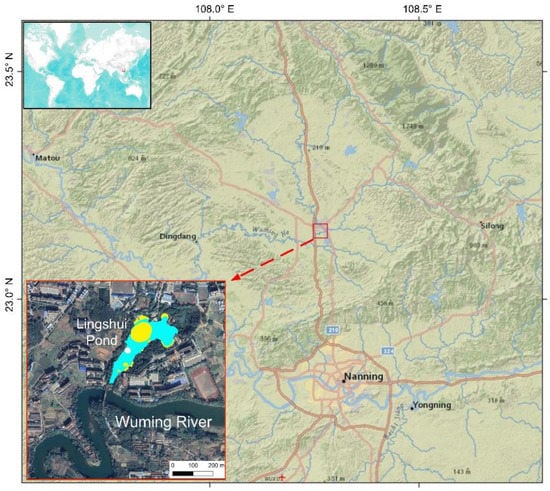
Figure 1.
Topographic map of the Wuming Basin; the location of Lingshui Pool (LSP) is indicated by a red square. The white circle in the satellite photograph of LSP (bottom left) is the coring site, while the water area of LSP is marked blue. The area with significant loss of macrophytes, mainly Vallisneria natansin, in 2013 is marked yellow.
The climatic conditions of this site are mainly affected by subtropical monsoon systems. The mean annual temperature is 21.9 °C, and the mean annual precipitation is 1247 mm. LSP is a small spring-fed pool with a surface area of 2.93 ha and a maximum depth of approximately 3 m [1]. It is recharged by groundwater from a spring and by precipitation, and it supplies water to ~13,000 people. Its southern outlet is dammed by a water gate that was built in 1962 and controls the outflow of lake water to the Wuming River. When the river experiences a severe flooding event, the river backflow carries organic matters and detrital minerals into LSP and causes a strong disturbance in the aquatic ecosystem. The increase of eutrophication after a flooding event is considered the main reason for the catastrophic loss of submerged plants, mainly Vallisneria natans, from LSP during 2010–2013 [6].
To collect the core, we drilled the lake bed (23.150311° N, 108.264317° E; 1.74 m water depth) in the southern section of LSP (Figure 1) using a Russian peat borer on a boat in April 2013. Using this method, a 96 cm long sediment core (LSH-2) was collected. We subsampled the sediment core at 1 cm intervals in the laboratory, then freeze-dried the samples before conducting further analysis.
Ten samples selected throughout the core were weighed and sent to the Institute of Earth Sciences, Academia Sinica, Taiwan, for 210Pb and 137Cs measurement. Because of the small amount of samples, we used well-type ORTEC HPGe detectors (LB-GWL) to measure radioisotope activity [18]. Since the core was not older than 100 years, the samples were unable to reach secular equilibrium between 210Pb and 226Ra, so we used the 137Cs maximum to pinpoint the 1963 peak that resulted from the global nuclear weapon tests [19].
2.2. Proxy Analyses
Analyses of acid-leachable elements were performed at the Department of Geosciences, National Taiwan University, Taiwan [15]. We used 0.5 g of the sediment from each of the 1 cm interval samples, and leached these samples with 10 mL of 0.5 N HCl in a 50 mL centrifuge tube overnight. The samples were centrifuged at 5000 rpm for 10 min, then the supernatants were collected. Then, 5 mL deionized water was added into the centrifuge tube and mixed with the residue to wash the sediment sample. After centrifuging, the supernatant was combined with the previous sample solution. This process was repeated three times until the pH of the supernatant became neutral. The supernatants were then moved to a 50 mL volumetric flask and deionized water was added for quantification. The solution was filtered through a 0.45 μm filter membrane before analysis. The supernatants collected from each sample were analyzed using inductively coupled plasma optical emission spectroscopy (ICP-OES) for the elements: Al, Ba, Ca, Cu, Fe, K, Li, Mg, Mn, Na, Pb, Sr, Ti, and Zn. For equipment calibration, standard reference materials and sample blanks were assessed before being analyzed. The geochemical data are presented as concentrations relative to dry sediment weight (mg/kg).
Diatoms were analyzed at 2 cm intervals, giving a total of 48 samples. We treated 0.1 g sediment samples with 5 mL 10% HCl and 5 mL 10% H2O2, then washed them in deionized water and mounted them with Mountmedia (Wako Pure Chemical Industries, Osaka, Japan). Three hundred diatom valves were identified and counted under a LEICA DM750 light microscope at 1000× magnification. The identification of diatom species and their ecological interpretation was conducted using information relating to freshwater diatom flora in assembled references [20,21,22,23,24,25]. Stratigraphic diagrams were drawn using the rioja package [26] in R v.4.12 [27] and C2 v.1.7.5 [28].
2.3. Data Analyses
The following statistical analyses were conducted: cluster analysis, α-diversity and β-diversity, principal components analysis (PCA), redundancy analysis (RDA), variance inflation factors (VIF), variation partitioning analysis (VPA), and correlation matrix computing. They were performed in R version v.4.12 [27], using the vegan, rioja, betapart, basic, and Hmisc packages [26,29,30,31].
A hierarchical cluster analysis was used to analyze the data relating to the 14 acid-leachable elements analyzed in the LSP sediment and to identify groups of analytes that exhibited similar trends in the LSP core [32]. To conduct the cluster analysis, we used an unweighted pair-group method with arithmetic mean, which involved taking Euclidean distances of the correlation matrix. A constrained incremental sum of squares (CONISS) cluster analysis was applied to the diatom data to identify the major zones of diatom assemblage change [33].
We used five species diversity indices to estimate the past diversity of diatoms in LSP. Species richness is expressed using Hill numbers corresponding to Chao’s species richness. Pielou’s index is used to represent species evenness [34]. We computed β-diversity using presence–absence data and the Sørensen index of dissimilarity. To capture the processes underlying species dissimilarity among communities, we partitioned the overall β-diversity values (β-sor) into species turnover (β-sim) and nestedness-resultant (β-sne) components [35].
For the gradient analysis, to mitigate the effect of rare taxa, only diatom species with a relative abundance of ≥3% in at least three samples were considered [36]. The remaining diatom data were square-root-transformed to stabilize the variance and reduce the effects of abundant taxa. The first axis of the detrended correspondence analysis (DCA) of the diatom data had a gradient length of 1.18 SD, which indicated that linear techniques such as PCA and RDA were appropriate for the diatom data. Thus, PCA was applied to identify the significant changes in diatom assemblages. RDA was used to identify the key environmental drivers of these changes. The broken-stick model was used to determine the number of diatom zones for the CONISS cluster analysis and to identify the significant axes for the PCA. Mean annual temperature and precipitation at LSP from 1957 to 2012 were retrieved from the Wuming County Meteorological Bureau. The historical weather data were then resampled using an interpolation method to fit the time series of diatom data before analysis.
3. Results
3.1. Sediment Chronology
The 210Pb and 137Cs data of the 10 measured samples were used to calculate the linear sedimentation rate (LSR). The profile of excess radioactive 210Pb showed an exponential decrease with increasing sedimentary depth (Figure 2a). Under the assumptions of a constant rate of 210Pb flux in the surface sediment and a constant sedimentation rate, the estimated LSR was 1.769 cm/y. The peak in 137Cs, which corresponded to atmospheric nuclear weapons testing in 1963, occurred at a depth of 84.5 cm (Figure 2b), for which the estimated 210Pb date was 1966. Based on this chronology, the 96 cm LSH-2 core spanned the interval from 1960 to 2013.
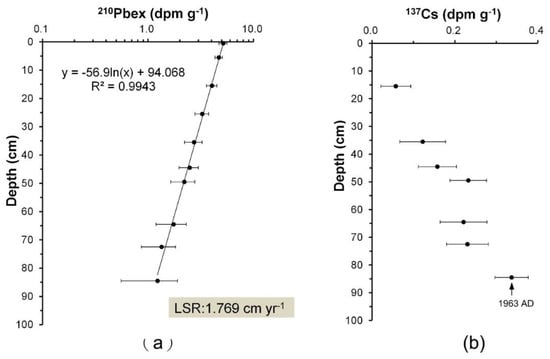
Figure 2.
The results of radiometric dating. (a) The sediment profile of excess 210Pb (210Pbex) and an estimation of the linear sedimentation rate (LSR). (b) The profile of 137Cs in the sediment core.
3.2. Sediment Geochemistry, Diatom Stratigraphy, and Diversity
The dendrogram calculated using cluster analysis divided the 14 leachable elements into four groups (Figure S1). A diagram showing the weak acid-leachable elements from LSP is presented in Figure 3. Group 1 contains only Pb (5–19 mg/kg), which was less abundant at depths of 46–26 cm. Group 2 contains Mn (129–686 mg/kg), Ba (29–86 mg/kg), Ti (32–197 mg/kg), Mg (980–2347 mg/kg), Al (2691–7329 mg/kg), and Fe (6662–39,789 mg/kg). Group 2 elements were enriched at depths of 90–70 cm. Group 3 contains Sr (3–34 mg/kg) and Ca (2447–118,482 mg/kg). Ca was the most abundant element in the LSP sediment. This group was most abundant in the 96–90 cm zone and also increased in the uppermost 40 cm of the sediment core. Group 4 contains K (37–732 mg/kg), Li (2–12 mg/kg), Na (8–106 mg/kg), Cu (6–63 mg/kg), and Zn (14–48 mg/kg), which were most abundant in the uppermost 50 cm of the sediment core.
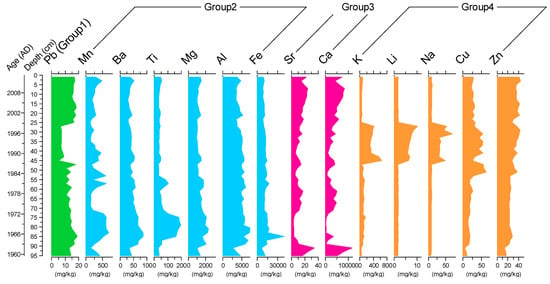
Figure 3.
Sediment profiles of 14 weak-acid–leachable elements. The four groups were identified based on cluster analysis results (Figure S1).
We identified 91 diatom taxa belonging to 34 genera in the sediment core (Table S1). We selected 14 taxa with a relative abundance ≥ 3% in at least three samples (Figure 4, Figure S2). The dominant assemblages in the sediment profile were epiphytic diatoms (10–82%), comprising Cocconeis placentula (4–80%), Cymbella affinis (0–7%), and Gomphonema clevei (0–18%). Benthic diatoms varied between 9% and 65% and included Achnanthes exigua (0–10%), Achnanthes lanceolata (1–27%), Achnanthes minutissima (5–21%), Eunotia minor (0–4%), Navicula cryptotenella (0–11%), Navicula elginensis (0–5%), Navicula minima (0–11%), and Nitzschia sinuata var. delognei (0–14%). Benthic-to-planktonic diatoms (0–48%) were relatively rare and comprised Pseudostaurosira brevistriata (0–17%), Punctastriata linearis (0–25%), and Staurosira construens (0–13%).
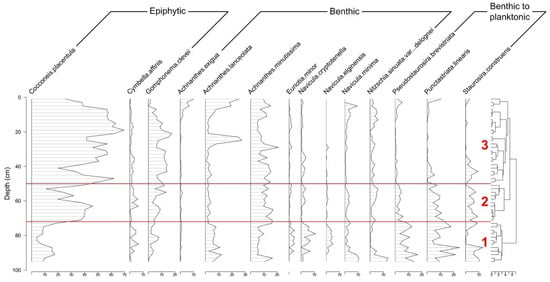
Figure 4.
Sediment profile of selected dominant diatom species, stratified into three diatom zones.
In terms of diatom stratigraphy, there were three distinct zones, according to the dendrogram produced in the CONISS cluster analysis. In Zone 1 (96–72 cm; 1960–1972), epiphytic taxa remained low in abundance (< 20%). The benthic taxa A. minutissima, N. minima, and N. sinuata var. delognei decreased rapidly when the benthic-to-planktonic taxon P. linearis increased, at a depth of 92 cm (1962). Between 92 and 72 cm, the frequency of the benthic taxa E. minor, N. cryptotenella, and N. elginensis rose gradually.
Zone 2 (72–48 cm; 1972–1985) covered a period with a rapid increase in epiphytic taxa, of which C. placentula and G. clevei were dominant. Of the benthic taxa, only A. minutissima was somewhat more abundant than in the previous period. Other benthic species, such as E. minor, N. cryptotenella, and N. elginensis, were generally scarce, with an average abundance lower than 1%. Benthic-to-planktonic taxa decreased substantially.
In Zone 3 (48–0 cm; 1985–2013) epiphytic taxa increased substantially. C. placentula and G. clevei dominated, but rapidly decreased in the uppermost 20 cm of the sediment core. Benthic taxa varied greatly: A. exigua and N. minima were increasing at the top of the zone, while A. lanceolata peaked twice in this period. The concentration of benthic-to-planktonic taxa was lower in Zone 3 than in the previous period.
Diatom richness ranged from 19 to 56; it peaked in Zone 1, remained high in Zone 2, and gradually decreased in Zone 3 (Figure 5). Diatom evenness showed a decreasing trend, ranging from 0.43 to 0.92. β-diversity (β-sor) is the sum of the turnover component (β-sim) and the nestedness-resultant component (β-sne). The β-diversity values decrease in Zone 1, remain low in Zone 2, and then increase again in Zone 3, ranging from 0.33 to 0.56. The β-sim showed a similar pattern to β-sor, ranging from 0.16 to 0.38. β-sne had a relatively low association with β-sor and varied from 0.07 to 0.24.
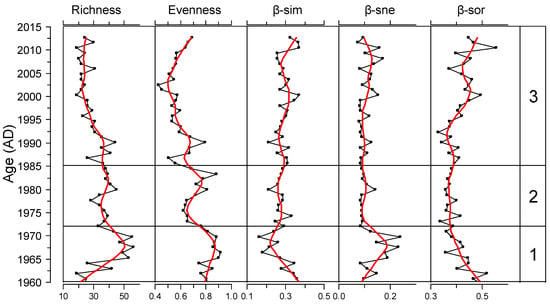
Figure 5.
Profile of species richness (richness), species evenness (evenness), and β-diversity (β-sim, β-sen, and β-sor) in the three diatom zones.
3.3. PCA Results
The PCA of the selected diatom assemblages showed that the first two PCA axes were statistically significant, accounting for 43.73% and 13.91% of the total variance, respectively (Figure 6, Table S2). PCA axis 1 (PC1) was strongly positively correlated with epiphytic taxa (C. placentula and G. clevei) and negatively correlated with benthic-to-planktonic taxa (P. brevistriata, P. linearis, and S. construens). C. placentula is dominant on the surface of emergent and submerged plants, and is an essential component of aquatic-plant-dominated shallow lakes [7,37]. Therefore, PC1 was considered a proxy for the area covered by aquatic plants in LSP. PC2 was strongly positively correlated with the eutraphentic species A. lanceolata, and negatively correlated with the meso-eutraphentic species G. clevei and the oligotraphentic species E. minor. Thus, PC2 may represent the nutrient conditions in LSP. This assumption was supported by a similar association between PC2 values and the variation in NO3− content in LSP water from 1977 to 2014 [5] (Figure S3).
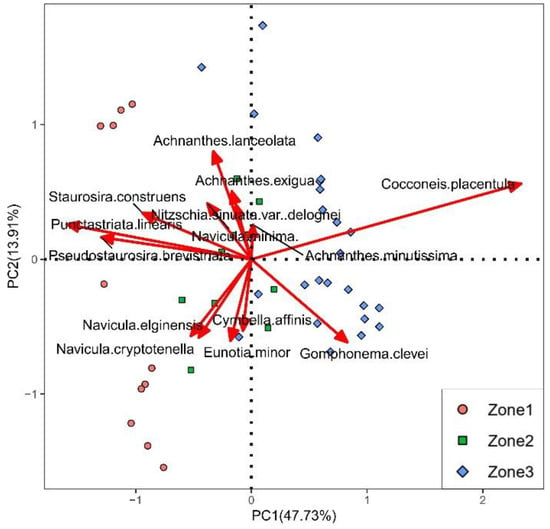
Figure 6.
PCA biplot of the dominant diatoms found in sediment from LSP.
4. Discussion
4.1. Reconstruction of the Status of LSP since 1960
Diatom and geochemistry records from LSP sediment showed a clear anthropogenic impact on the spring lake existing in a karst region. Our age model revealed a 96 cm-thick deposition in LSP post 1960, of which only 4 cm of the sediment was deposited before the water gate was built in 1962. The high percentage of benthic diatoms (Figure 7) in the bottom layers of the sediment profile revealed that the pond was shallow before 1962. The diatom species that were abundant at this time had low values on PC1 and PC2, indicating that there were very few aquatic plants and that the water body was oligo- to mesotrophic. The springs that feed LSP mainly discharge into it with a flow velocity of 0.03–0.22 m/s [6]. This high flow velocity may limit eutrophication and impede sediment deposition processes in LSP under natural conditions.
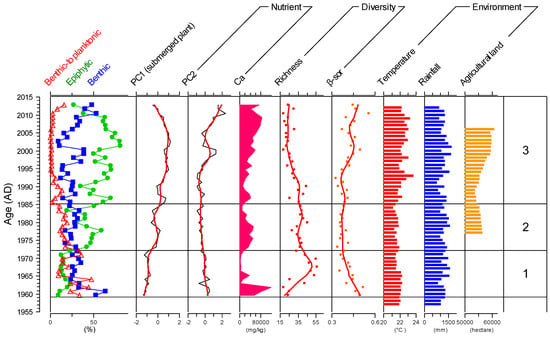
Figure 7.
Summary of diatom habitat preference (benthic-to-planktonic, epiphytic, and benthic), submerged macrophyte coverage (PC1), nutrient concentration (PC2, Ca), diversity estimates (richness, β-sor), and environmental factors (temperature, rainfall, and agriculture land), as inferred from sedimentary proxies and historical records for 1960–2013.
The ratio of planktonic to benthic diatoms can reflect changes in lake level [7,38], and the rapid increase in benthic-to-planktonic diatoms in LSP may correlate with an increase in the lake level after the dam construction in 1962. The Ca2+ content of LSP water was >75 mg/L [1], and Ca was the main carbonate element in the sediment (Figure 7). High Ca peaks in deposition can represent spikes in primary productivity, because microalgal blooms can enhance biomass and carbonate precipitation [39]. However, the nutrient-proxy PC2 remained low when Ca peaked in 1962. Anthropogenic activity, such as construction near the lake, may thus have increased the Ca content of the sediment [40]. The high peak of Ca in 1962 may therefore be correlated with the dam construction rather than eutrophic conditions. Group 2 leachable elements were highly enriched between 1962 and 1972. Mg is a common carbonate element that comes from terrigenous clay minerals. Ti, Al, and Fe are generally common crustal elements, with sources such as soil dust and runoff erosion [32]. Mn is preferentially reduced and indicates lake-level status [15]. Therefore, the increase in Group 2 elements during 1962–1972 indicates a higher lake level with more terrigenous mineral input from the watershed.
During 1972–1985, the gradual increase in epiphytic assemblages and PC1 values indicates enhanced macrophyte coverage in LSP. The slightly decreasing trend in benthic-to-planktonic assemblages and Group 2 elements may correlate with a lower lake level due to a high sedimentation rate that filled up the LSP. PC2 and Ca remained low, reflecting oligo- to mesotrophic conditions. It is known that, before 1985, China had a low production rate and slow development. The economic reforms in China began around 1985. Since then, the rapid development in economics has strongly affected environmental conditions.
During 1985–2013, the hydrological regime changed substantially. Group 4 elements are considered representative of anthropogenic pollution. K, Li, and Na represent moderate pollution potential, while Cu and Zn represent very high pollution potential [41]. The elements K, Li, and Na increased in 1985–1999, reflecting an increase in human pollution. The dominant epiphytic diatoms and high PC1 values indicated that the area covered with macrophytes was larger than in the previous period. The total agricultural acreage in the basin has gradually increased since 1989, which has caused changes in groundwater conditions since 1990 [5]. Increases in PC2 and Ca coincided with the increase in agricultural land, reflecting human-induced eutrophication. The rise in Zn also indicated that there were very high pollution levels during this period.
The environmental degradation of LSP was thought to be correlated to frequent river backflow events, which are caused by reduced upstream discharge and increased water consumption [6]. River backflow delivers excess pollutants, microorganisms, and nutrients into LSP, and eventually causes microalgal blooms and the extinction of submerged plants.
4.2. Causes of Diatom-Diversity Changes and Strategies for Lake Ecosystem Restoration
The impacts of climate and human behavior are the primary forcing factors of diatom diversity dynamics in lake ecosystems. Shifts in diatom assemblages can respond rapidly to natural and anthropogenic disturbances. A correlation analysis of the relationships between diatom richness, diatom evenness, PC1 (submerged macrophyte coverage), PC2 (nutrients), temperature, and precipitation was used to evaluate the primary factors that influence diatom diversity (Figure 8). Biological α-diversity comprises both species richness and species evenness. In the LSP sediment records, the richness and evenness of diatom communities were significantly positively correlated. A metareview of the diversity of aquatic ecosystems suggested that communities of autotrophs such as diatoms have a strongly positive relationship between species richness and evenness [42]. Diatom richness also exhibited a strongly negative correlation with PC2. Eutrophication is a critical forcing factor of biotic homogenization in freshwater ecosystems. Biotic homogenization can be characterized as a reduction in α-diversity [43]. Human-induced eutrophication is the most significant environmental contributor to biodiversity degradation in LSP. LSP is a spring-fed lake with minimal fluctuations in water properties and limited input of allochthonous organisms from other environments because of continuous renewal of the aquatic environment from springs [5,44]. The low species richness in LSP post-1985 indicates a shift in regional groundwater quality, as a result of urbanization and agricultural development.
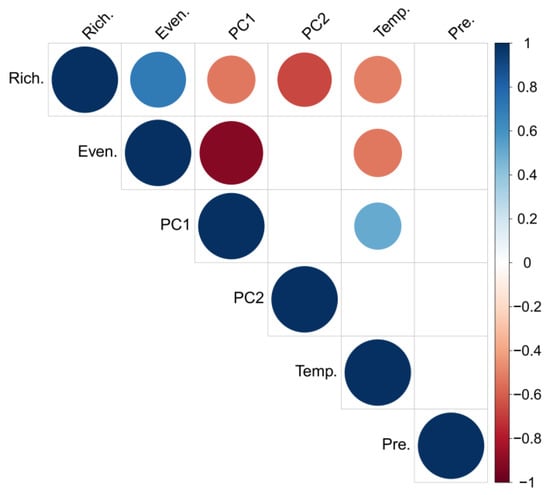
Figure 8.
A correlogram of the diatom-inferred proxies including richness (rich.), evenness (even.), PCA axis 1 (PC1), and PCA axis 2 (PC2) with the meteorological data such as temperature (temp.) and precipitation (pre.) during 1960–2013 in LSP. In the plot, the color bar on the right side shows the correlation values.
Diatom evenness was negatively correlated with PC1 (correlation value between −0.8 and −1, Figure 8), which suggested that the increasing submerged macrophyte population was the primary cause of decreasing diatom evenness. The main source of variation in diatom composition in freshwater ecosystems is substrate type [45]. The increasing macrophyte coverage may have reduced the lake-bottom-substrate habitat type, allowing a monodominant community of epiphytic diatoms to form. The increase in diatom evenness since 2004 was a consequence of the increasing benthic habitat because of the loss of the macrophyte population in LSP, which was caused by accelerating eutrophication [46,47].
Species richness and evenness both showed a weak negative correlation with temperature (The correlation values are around −0.4, Figure 8). Diatom α-diversity decreased after 1990 in LSP, which was presumably a response to rapid global warming, consistent with results from an alpine lake with relatively low levels of human impact [17,48]. Precipitation had a non-significant impact on the diatom assemblage, although the increase in water consumption from LSP due to urbanization may have interfered with the signal of rainfall [6].
Total β-diversity (β-sor) reflects spatial species turnover and species nestedness, in other words species replacement and species loss. The differentiation of these two components is needed for a regional conservation plan, because it can improve understanding of biogeographical, ecological, and conservation issues [49]. The species turnover component (β-sim) decreased rapidly in 1964 and increased dramatically in 2010, reflecting the two significant disturbances to the diatom assemblage: dam construction and loss of macrophytes. The species nestedness component (β-nes) showed a positive correlation with species richness during the oligotrophic period (1960–1990), but this relationship became negative during the eutrophic period (1990–2013). This result suggests that eutrophication and lower species richness led to increasing rates of species loss [43].
The species-turnover component contributed most strongly to total β-diversity and was negatively correlated with species richness. Changes in β-diversity are based on the balance between the biotic heterogenization and homogenization processes. The eutrophication process may have caused homogenization of the diatom assemblage and increased the β-diversity in LSP, consistent with results from other studies [43,49,50]. Due to the likelihood of intense urbanization in the future, we may predict that species richness will inevitably continue to decline unless effective conservation strategies are adopted.
Paleolimnological data indicated that the diatom assemblage was diverse and stable when submerged macrophytes were present. Therefore, the recovery of endemic macrophytes may help to conserve this shallow lake ecosystem. V. natans is the most dominant submerged macrophyte in LSP. This species is also valuable for ecosystem restoration because it aids in maintaining healthy freshwater ecosystems by improving water quality, by supplying substrates for microorganisms, and by providing food for waterfowl [51,52].
Anthropogenic pollution and high-nutrient sediments can lead to declines in submerged macrophytes and diatom diversity [47,53]. Our examination of leachable elements revealed low levels of heavy metal pollution in LSP (Figure 3). High PC2 values suggested that there has been high productivity since 1990, and that the upper 40 cm of the sediment core may contain high levels of nutrients. Sediment dredging of upper organically rich sediment may reduce nutrient release and improve the waterbody’s health.
When the nutrient concentration is low, V. natans may grow well on the lake bottom at a water depth of 200 cm. The deepest water depth at which V. natans can survive decreases in a eutrophic lake due to the growth of phytoplankton, which results in reduced water transparency and shallower light penetration [54]. Compared with the historical NO3− records (Figure S3), the coverage of macrophytes (PC1) in LSP has decreased gradually since 2004, when NO3− concentration exceeded 3 mg/L, and then decreased rapidly to a minimum in 2011, when NO3− concentration exceeded 7 mg/L. The catastrophic loss of submerged plants from 2010 to 2013 noted in field observations supports our findings (Figure 1) [6]. Today, the mean lake depth of LSP is generally deeper than 200 cm. The level of LSP could be the main factor determining the coverage of submerged macrophytes [46]. Maintaining a water depth shallower than 120 cm would allow greater light penetration to the sediment, leading to the increased growth of V. natans [46].
In conclusion, the 53-year diatom and geochemical records from LSP revealed hydrological changes and allowed us to link diatom diversity to anthropogenic disturbances, including dam construction and rapid eutrophication. High diatom species richness after the dam’s construction may be related to the increasing environmental heterogeneity in oligotrophic water. In contrast, the rapid decrease in species richness after 1990 was the consequence of eutrophication due to regional agricultural development and climate warming. The recovery of endemic submerged macrophytes would benefit the conservation of this spring-fed pond ecosystem.
Supplementary Materials
The following are available online at https://www.mdpi.com/article/10.3390/d14030166/s1. Figure S1: Dendrogram of a cluster analysis of 14 leachable elements in the LSP sediment core. Figure S2: Light microscope images of the 14 main diatom taxa in the Lingshui Pond sediment core. 1–2: Achnanthes exigua; 3–4: Achnanthes lanceolata; 5–8: Achnanthes minutissima; 9–11: Cocconeis placentula; 12–14: Cymbella affinis; 15: Eunotia minor; 16–19: Gomphonema clevei; 20: Navicula cryptotenella; 21: Navicula elginensis; 22: Navicula minima, 23: Nitzschia sinuata var. delognei; 24–25: Pseudostaurosira brevistriata; 26-28: Punctastriata linearis; 29: Staurosira construens. Figure S3: Spatial variation in PC2 in relation to diatoms from the sediment records, and NO3− concentration in spring water from LSP. Table S1: Checklist of diatom species found in the LSP sediment cores. Table S2: Scores of PCA and environmental conditions for the selected diatom species in the Lingshui Pond sediment core.
Author Contributions
Conceptualization, L.-C.W.; formal analysis, L.-C.W.; data curation, L.-C.W.; writing and original draft preparation, L.-C.W.; writing, reviewing, and editing, L.-C.W., H.-C.L. and L.-J.S.; supervision, L.-C.W.; funding acquisition, L.-C.W. and H.-C.L. All authors have read and agreed to the published version of the manuscript.
Funding
This research was funded by the Ministry of Science and Technology, Taiwan (grant number MOST 108-2116-M-194-003-, MOST 109-2116-M-194-011-, and MOST 110-2116-M-194-008-).
Institutional Review Board Statement
Not applicable.
Informed Consent Statement
Not applicable.
Data Availability Statement
The data presented in this study are available on request from the corresponding author.
Acknowledgments
We thank Guanghui Jiang, and Fang Guo of Key Laboratory of Karst Dynamics, MNR/Guangxi, Institute of Karst Geology, Chinese Academy of Geological Sciences, Guilin, China for their help in core drilling and field excursion.
Conflicts of Interest
The authors declare no conflict of interest.
References
- Guo, F.; Jiang, G.; Zhao, H.; Polk, J.; Liu, S. Physicochemical Parameters and Phytoplankton as Indicators of the Aquatic Environment in Karstic Springs of South China. Sci. Total Environ. 2019, 659, 74–83. [Google Scholar] [CrossRef]
- Zhao, M.; Zeng, C.; Liu, Z.; Wang, S. Effect of Different Land Use/Land Cover on Karst Hydrogeochemistry: A Paired Catchment Study of Chenqi and Dengzhanhe, Puding, Guizhou, SW China. J. Hydrol. 2010, 388, 121–130. [Google Scholar] [CrossRef]
- Qicai, L. Influence of Dams on River Ecosystem and Its Countermeasures. J. Water Resour. Prot. 2011, 3, 60–66. [Google Scholar] [CrossRef]
- Zhang, Y.; Liao, J.; Pei, Z.; Lu, X.; Xu, S.; Wang, X. Effect of Dam Construction on Nutrient Deposition from a Small Agricultural Karst Catchment. Ecol. Indic. 2019, 107, 105548. [Google Scholar] [CrossRef]
- Guo, F.; Jiang, G.; Polk, J.S.; Huang, X.; Huang, S. Resilience of Groundwater Impacted by Land Use and Climate Change in a Karst Aquifer, South China. Water Environ. Res. 2015, 87, 1990–1998. [Google Scholar] [CrossRef]
- Guo, F.; Jiang, G. Hydro-Ecological Processes of Hyporheic Zone in a Karst Spring-Fed Pool: Effects of Groundwater Decline and River Backflow. J. Hydrol. 2020, 587, 124987. [Google Scholar] [CrossRef]
- Wang, L.-C.; Chou, Y.-M.; Chen, H.-F.; Chang, Y.-P.; Chiang, H.-W.; Yang, T.-N.; Shiau, L.-J.; Chen, Y.-G. Paleolimnological Evidence for Lacustrine Environmental Evolution and Paleo-Typhoon Records during the Late Holocene in Eastern Taiwan. J. Paleolimnol. 2021, 1–17. [Google Scholar] [CrossRef]
- Wang, L.-C. Using Paleoecological Data to Inform the Conservation Strategy for Floristic Diversity and Isoetes Taiwanensis in Northern Taiwan. Diversity 2021, 13, 395. [Google Scholar] [CrossRef]
- Thevenon, F.; Guédron, S.; Chiaradia, M.; Loizeau, J.-L.; Poté, J. (Pre-) Historic Changes in Natural and Anthropogenic Heavy Metals Deposition Inferred from Two Contrasting Swiss Alpine Lakes. Quat. Sci. Rev. 2011, 30, 224–233. [Google Scholar] [CrossRef]
- Wang, L.-C.; Tang, Z.-W.; Chen, H.-F.; Li, H.-C.; Shiau, L.-J.; Huang, J.-J.S.; Wei, K.-Y.; Chuang, C.-K.; Chou, Y.-M. Late Holocene Vegetation, Climate, and Natural Disturbance Records from an Alpine Pond in Central Taiwan. Quat. Int. 2019, 528, 63–72. [Google Scholar] [CrossRef]
- Wang, L.-C.; Chang, Y.-P.; Li, H.-C.; Chen, S.-H.; Wu, J.-T.; Lee, T.-Q.; Shiau, L.-J. Revealing the Vegetation, Fire and Human Activities in the Lowland of Eastern Taiwan during Late Holocene. Quat. Int. 2020, 544, 32–40. [Google Scholar] [CrossRef]
- Birks, H.H.; Birks, H.J.B. Multi-Proxy Studies in Palaeolimnology. Veg. Hist. Archaeobot. 2006, 15, 235–251. [Google Scholar] [CrossRef]
- Xue, H.; Zheng, B.; Meng, F.; Wang, Y.; Zhang, L.; Cheng, P. Assessment of Aquatic Ecosystem Health of the Wutong River Based on Benthic Diatoms. Water 2019, 11, 727. [Google Scholar] [CrossRef]
- Wojtal, A.Z.; Sobczyk, Ł. The Influence of Substrates and Physicochemical Factors on the Composition of Diatom Assemblages in Karst Springs and Their Applicability in Water-Quality Assessment. Hydrobiologia 2012, 695, 97–108. [Google Scholar] [CrossRef][Green Version]
- Wang, L.-C.; Behling, H.; Chen, Y.-M.; Huang, M.-S.; Chen, C.-T.A.; Lou, J.-Y.; Chang, Y.-P.; Li, H.-C. Holocene Monsoonal Climate Changes Tracked by Multiproxy Approach from a Lacustrine Sediment Core of the Subalpine Retreat Lake in Taiwan. Quat. Int. 2014, 333, 69–76. [Google Scholar] [CrossRef]
- Li, H.-C.; Bischoff, J.L.; Ku, T.-L.; Zhu, Z.-Y. Climate and Hydrology of the Last Interglaciation (MIS 5) in Owens Basin, California: Isotopic and Geochemical Evidence from Core OL-92. Quat. Sci. Rev. 2004, 23, 49–63. [Google Scholar] [CrossRef]
- Zou, Y.; Wang, L.; Xu, H.; Yan, Y.; Zhang, J.; Liu, Y.; Li, P.; Peng, Z.; Gu, Z.; Lu, H. Do Changes in Water Depth and Water Level Influence the Diatom Diversity of Yunlong Lake, in Yunnan Province, Southwest China? J. Paleolimnol. 2020, 64, 273–291. [Google Scholar] [CrossRef]
- Huh, C.-A.; Chen, W.; Hsu, F.-H.; Su, C.-C.; Chiu, J.-K.; Lin, S.; Liu, C.-S.; Huang, B.-J. Modern (<100 Years) Sedimentation in the Taiwan Strait: Rates and Source-to-Sink Pathways Elucidated from Radionuclides and Particle Size Distribution. Cont. Shelf Res. 2011, 31, 47–63. [Google Scholar] [CrossRef]
- von Gunten, L.; Grosjean, M.; Beer, J.; Grob, P.; Morales, A.; Urrutia, R. Age Modeling of Young Non-Varved Lake Sediments: Methods and Limits. Examples from Two Lakes in Central Chile. J. Paleolimnol. 2009, 42, 401–412. [Google Scholar] [CrossRef]
- Wang, L.-C.; Lee, T.-Q.; Chen, S.-H.; Wu, J.-T. Diatoms in Liyu Lake, Eastern Taiwan. Taiwania 2010, 55, 228–242. [Google Scholar]
- Watanabe, T.; Ohtsuka, T.; Tuji, A.; Houki, A. Picture Book and Ecology of the Freshwater Diatoms; Uchidarokakuho: Tokyo, Japan, 2005. [Google Scholar]
- Wu, J.-T.; Babu, B.; Chou, C.-L.; Saraswathi, S.J. Freshwater Diatom Flora of Taiwan; Biodiversity Research Center, Academia Sinica: Taipei, Taiwan, 2011; p. 747. [Google Scholar]
- Wang, Q.; Zhi, C.; Hamilton, P.; Kang, F. Diatom Distributions and Species Optima for Phosphorus and Current Velocity in Rivers from ZhuJiang Watershed within a Karst Region of South-Central China. Fundam. Appl. Limnol. 2009, 175, 125. [Google Scholar] [CrossRef]
- Tan, X.; Sheldon, F.; Bunn, S.E.; Zhang, Q. Using Diatom Indices for Water Quality Assessment in a Subtropical River, China. Environ. Sci. Pollut. Res. 2013, 20, 4164–4175. [Google Scholar] [CrossRef] [PubMed]
- Kobayasi, H.; Idei, M.; Mayama, S.; Nagumo, T.; Osada, K.H. Kobayasi’s Atlas of Japanese Diatoms Based on Electron Microscopy; Uchidarokakuho: Tokyo, Japan, 2006. [Google Scholar]
- Juggins, S. Rioja: Analysis of Quaternary Science Data, R Package Version (0.9–26). 2020. Available online: https://cran.r-project.org/package=rioja (accessed on 17 January 2022).
- R Core Team. R: A Language and Environment for Statistical Computing; R Core Team: Vienna, Austria, 2021. [Google Scholar]
- Juggins, S. C2 Version 1.5: Software for Ecological and Palaeoecological Data Analysis and Visualisation; University of Newcastle: Newcastle, Australia, 2005. [Google Scholar]
- Oksanen, J.; Blanchet, F.G.; Kindt, R.; Legendre, P.; O’Hara, R.G.; Simpson, G.L.; Solymos, P.; Stevens, M.; Wagner, H. Multivariate Analysis of Ecological Communities in R: Vegan Tutorial. R Package Version 1.7. 2013. Available online: https://CRAN.R-project.org/package=vegan (accessed on 17 January 2022).
- Baselga, A.; Orme, C.D.L. Betapart: An R Package for the Study of Beta Diversity. Methods Ecol. Evol. 2012, 3, 808–812. [Google Scholar] [CrossRef]
- Harrell, F.E.; Dupont, C. Hmisc: Harrell Miscellaneous. R Package Version 4.1-1. 2018. Available online: https://CRAN.R-project.org/package=Hmisc (accessed on 17 January 2022).
- Aliff, M.N.; Reavie, E.D.; Post, S.P.; Zanko, L.M. Anthropocene Geochemistry of Metals in Sediment Cores from the Laurentian Great Lakes. PeerJ 2020, 8, e9034. [Google Scholar] [CrossRef] [PubMed]
- Grimm, E.C. CONISS: A FORTRAN 77 Program for Stratigraphically Constrained Cluster Analysis by the Method of Incremental Sum of Squares. Comput. Geosci. 1987, 13, 13–35. [Google Scholar] [CrossRef]
- Pielou, E.C. Species-Diversity and Pattern-Diversity in the Study of Ecological Succession. J. Theor. Biol. 1966, 10, 370–383. [Google Scholar] [CrossRef]
- Song, B.; Wang, R.; Wang, Q.; Kong, L.; Hu, Z.; Zheng, W.; Yang, X. Pollen and Diatom Record Long-Term Complex Relationships between Diversity and Stability in a Lake and Nearby Vegetation from Tingming Lake in Yunnan, SW China. Quat. Int. 2021, 580, 87–94. [Google Scholar] [CrossRef]
- Jantz, N.; Behling, H. A Holocene Environmental Record Reflecting Vegetation, Climate, and Fire Variability at the Páramo of Quimsacocha, Southwestern Ecuadorian Andes. Veg. Hist. Archaeobot. 2012, 21, 169–185. [Google Scholar] [CrossRef][Green Version]
- Rojas, L.A.; Hassan, G.S. Distribution of Epiphytic Diatoms on Five Macrophytes from a Pampean Shallow Lake: Host-Specificity and Implications for Paleoenvironmental Reconstructions. Diatom Res. 2017, 32, 263–275. [Google Scholar] [CrossRef]
- Wang, P.X.; Wang, B.; Cheng, H.; Fasullo, J.; Guo, Z.T.; Kiefer, T.; Liu, Z.Y. The Global Monsoon across Timescales: Coherent Variability of Regional Monsoons. Clim. Past 2014, 10, 2007–2052. [Google Scholar] [CrossRef]
- Chin, Z.W.; Arumugam, K.; Ashari, S.E.; Faizal Wong, F.W.; Tan, J.S.; Ariff, A.B.; Mohamed, M.S. Enhancement of Biomass and Calcium Carbonate Biomineralization of Chlorella Vulgaris through Plackett–Burman Screening and Box–Behnken Optimization Approach. Molecules 2020, 25, 3416. [Google Scholar] [CrossRef] [PubMed]
- Chen, H.-F.; Wei, K.-Y.; Huang, J.-J.S.; Lin, C.-C.; Su, C.-C.; Song, G.-S.; Li, H.-C.; Lee, T.-Q.; Song, S.-R.; Pan, H.-J. High-Resolution Records of Anthropogenic Activity and Geohazards from the Reservoir of Sun Moon Lake, Central Taiwan. Elem. Sci. Anthr. 2021, 9, 00150. [Google Scholar] [CrossRef]
- Chuan, O.M.; Yunus, K. Metals Pollution in Tropical Wetlands. In Wetlands Management-Assessing Risk and Sustainable Solutions; IntechOpen: London, UK, 2019; pp. 29–44. [Google Scholar]
- Soininen, J.; Passy, S.; Hillebrand, H. The Relationship between Species Richness and Evenness: A Meta-Analysis of Studies across Aquatic Ecosystems. Oecologia 2012, 169, 803–809. [Google Scholar] [CrossRef] [PubMed]
- Zorzal-Almeida, S.; Bartozek, E.C.R.; Bicudo, D.C. Homogenization of Diatom Assemblages Is Driven by Eutrophication in Tropical Reservoirs. Environ. Pollut. 2021, 288, 117778. [Google Scholar] [CrossRef]
- Cantonati, M.; Gerecke, R.; Bertuzzi, E. Springs of the Alps–Sensitive Ecosystems to Environmental Change: From Biodiversity Assessments to Long-Term Studies. Hydrobiologia 2006, 562, 59–96. [Google Scholar] [CrossRef]
- Pla-Rabés, S.; Catalan, J. Diatom Species Variation between Lake Habitats: Implications for Interpretation of Paleolimnological Records. J. Paleolimnol. 2018, 60, 169–187. [Google Scholar] [CrossRef]
- Xu, W.; Hu, W.; Deng, J.; Zhu, J.; Zhou, N.; Liu, X. Impacts of Water Depth and Substrate Type on Vallisneria Natans at Wave-Exposed and Sheltered Sites in a Eutrophic Large Lake. Ecol. Eng. 2016, 97, 344–354. [Google Scholar] [CrossRef]
- Gu, J.; Xu, Z.; Jin, H.; Ning, X.; He, H.; Yu, J.; Jeppesen, E.; Li, K. Response of Vallisneria Natans to Increasing Nitrogen Loading Depends on Sediment Nutrient Characteristics. Water 2016, 8, 563. [Google Scholar] [CrossRef]
- Yan, Y.; Wang, L.; Li, J.; Li, J.; Zou, Y.; Zhang, J.; Li, P.; Liu, Y.; Xu, B.; Gu, Z.; et al. Diatom Response to Climatic Warming over the Last 200years: A Record from Gonghai Lake, North China. Palaeogeogr. Palaeoclimatol. Palaeoecol. 2018, 495, 48–59. [Google Scholar] [CrossRef]
- Baselga, A. Partitioning the Turnover and Nestedness Components of Beta Diversity. Glob. Ecol. Biogeogr. 2010, 19, 134–143. [Google Scholar] [CrossRef]
- Wang, R.; Hu, Z.; Wang, Q.; Xu, M.; Zheng, W.; Zhang, K.; Yang, X. Discrepancy in the Responses of Diatom Diversity to Indirect and Direct Human Activities in Lakes of the Southeastern Tibetan Plateau, China. Anthropocene 2020, 30, 100243. [Google Scholar] [CrossRef]
- Li, L.; Bonser, S.P.; Lan, Z.; Xu, L.; Chen, J.; Song, Z. Water Depth Affects Reproductive Allocation and Reproductive Allometry in the Submerged Macrophyte Vallisneria Natans. Sci. Rep. 2017, 7, 16842. [Google Scholar] [CrossRef] [PubMed]
- Fu, F.; Huang, S.; Yuan, J.; Du, Z.; Cao, Y.; Yuan, H.; Zhou, W.; Wu, J.; Yi, H.; Chen, B.; et al. Effect Evaluation of Remediation in Three Typical Rivers with Vallisneria Natans under Different Pollution and Spatial Characterization of Functional Microorganisms. Ecol. Eng. 2021, 171, 106353. [Google Scholar] [CrossRef]
- Wang, Z.; Yao, L.; Liu, G.; Liu, W. Heavy Metals in Water, Sediments and Submerged Macrophytes in Ponds around the Dianchi Lake, China. Ecotoxicol. Environ. Saf. 2014, 107, 200–206. [Google Scholar] [CrossRef] [PubMed]
- Yuan, G.; Cao, T.; Fu, H.; Ni, L.; Zhang, X.; Li, W.; Song, X.; Xie, P.; Jeppesen, E. Linking Carbon and Nitrogen Metabolism to Depth Distribution of Submersed Macrophytes Using High Ammonium Dosing Tests and a Lake Survey. Freshw. Biol. 2013, 58, 2532–2540. [Google Scholar] [CrossRef] [PubMed]
Publisher’s Note: MDPI stays neutral with regard to jurisdictional claims in published maps and institutional affiliations. |
© 2022 by the authors. Licensee MDPI, Basel, Switzerland. This article is an open access article distributed under the terms and conditions of the Creative Commons Attribution (CC BY) license (https://creativecommons.org/licenses/by/4.0/).